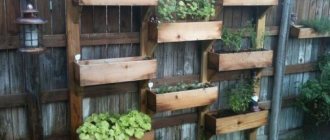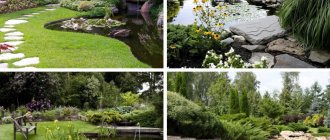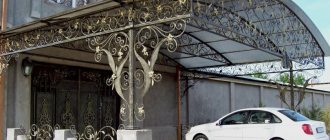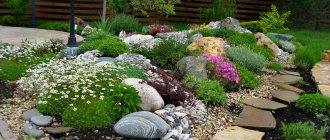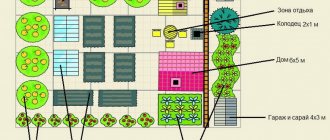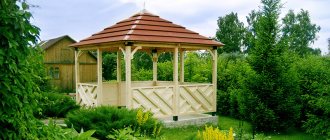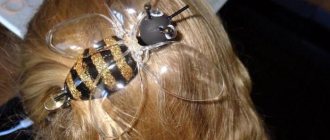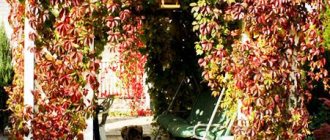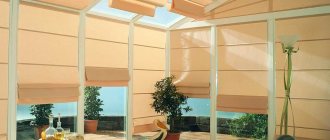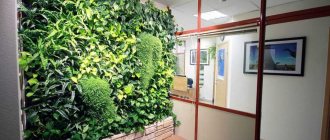Pros and cons of an artificial waterfall
An artificial waterfall is a beautiful element of landscape design.
A garden artificial waterfall has many advantages:
- The water falling through the levels has a strong calming effect. The therapeutic effect of a small cascade or fountain is higher than that of a pond.
- An original solution in a garden landscape.
- The water cascade provides constant high humidity over a fairly large area. Moisture-loving plants can be planted on the “banks” of the waterfall. At the same time, there is no need to equip them with an additional irrigation system.
- The design of artificial cascades is simple and changes little, but the design and dimensions can vary within very wide limits.
Minuses:
- This is an expensive decoration. To ensure sufficient water circulation, you will need to install a pump, pipes, and a drainage system.
- If there is no natural elevation on the site, you will have to build the ledges yourself, and this requires time and expense.
- Caring for a waterfall is just as difficult and time-consuming as caring for a pond.
It is believed that flowing water purifies itself, so artificial streams, unlike fountains and ponds, do not need disinfection and cleaning. However, this is a wrong opinion.
Outdoor installation
You should consider a method for making an artificial glass waterfall that will be installed outdoors. This design resembles a real waterfall, with the only difference being that the water in such a waterfall flows over a glass surface.
To create such a waterfall yourself, you need:
- beam;
- wooden boards;
- veneer;
- paraffin paste;
- masking tape;
- tempered glass of the required size;
- low-power sediment for water circulation;
- plastic pipe;
- brackets with fasteners;
- decorative stones.
Using wooden boards, you need to make a box that is the right size for the glass. The inside of this structure should be treated with paraffin paste. This will protect the wood from contact with water. In addition, it is necessary to treat the wood with antiseptic agents .
Choosing a location for installation

To find a suitable place for a home waterfall, you need to take into account many different factors.
First of all, it is necessary to calculate the distance from residential facilities. A waterfall is a water source, and even if the water in it is not potable, it is considered precisely as a source. All mandatory sanitary standards apply to it:
- The distance from a residential building to an artificial reservoir reaches 5 m. It is possible to reduce the distance if the site has a pronounced relief.
- There must be at least 10 m from the reservoir to the toilet or septic tank.
- From a barn with animals or birds - at least 20 m, to a shed with equipment - 5 m.
The distance to trees and bushes is not standardized, since the waterfall acts as an element of the garden landscape.
The next factor is the topography of the country yard. The easiest way is to take advantage of the existing height difference: lay out steps, install several stones. If there is none, build a stone slide in any suitable place.
Equip a waterfall at your dacha with your own hands on the shore of a reservoir. If it is already planned to place an artificial lake on the site, it is better to arrange a waterfall there.
An important factor is the aesthetic side. Most often, a cascade or fountain is installed within sight of the house. But if the plot is large enough and the garden occupies a large area, it is better to place the waterfall in the depths of the garden, in the recreation area.
Types of decorative waterfalls

There are a considerable number of decorative home waterfalls:
- Classic - imitates a natural pond as closely as possible with several “steps” made of stone. Water flows from level to level without creating much noise, but makes a splash due to falling from a height. Often they limit themselves to some semblance of a stream going down the slope into a lake.
- Cascade - in such a structure it is important to create a large difference in height so that the falling stream makes noise, foams and even jumps from stone to stone. This is not that difficult to achieve. The dimensions of the cascade option for a country house may be different.
- Flowing - a “quieter” model. The levels are located one above the other, looking like bowls. Water flows from the upper bowl to the lower one. Such a waterfall in a small garden is the best place for meditation.
- The wall is a very impressive idea, but requires a lot of effort. Water falls in a continuous stream from a great height of at least 1.5 m into the reservoir. For the waterfall to function, a large volume of water and powerful equipment will be required. A very original option is when such a “wall” is mounted directly on the wall of the house.
- Mini waterfall wall, a kind of lightweight modification. Several holes are made in the wall, from which water falls into the lake below. Often cascades are combined with “streams” of greenery.
- A grotto is a complex structure installed in the depths of the garden. Here the water source is placed deep in an artificial stone cave. The pond is designed as naturally as possible using natural stone and greenery. The grotto is often illuminated, which makes this element of the garden especially beautiful.

Grotto
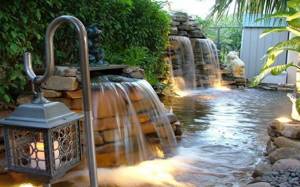
Wall
Even the simplest waterfall or fountain for home can be used in the garden. Such a device is left outside in the summer and dismantled in the winter.
Recommendations for choosing a decorative waterfall for an apartment
Having decided to buy a waterfall for your home, you should take into account several recommendations that will help you not make a mistake and choose this element in such a way that the waterfall brings only positive emotions to others.
First of all, decide on the type of waterfall, which should fit harmoniously into the overall design of the room.
There are several types of decorative waterfalls:
- waterfalls on glass;
- waterfalls on rocks;
- string waterfalls;
- bubble-panel waterfalls.
First, let's deal with glass waterfalls. Before choosing such a waterfall, you should accurately determine its location. There are several options for making this waterfall. Firstly, the glass waterfall is installed near the wall, but separately from it. In this case, it does not take up much space. To build such a waterfall, you should decide on the design of its racks and their finishing. If the height of such a waterfall exceeds 2 m, special clamps should be installed to prevent the structure from tipping over. The design options for the decorative part, which is located next to the wall, are also different. It is possible to order regular glass, but at a time when the waterfall will not work, the wallpaper or wall decoration will be visible. It is better to choose a decorative film that depicts stones or vegetation. It is possible to use a mirror surface or frosted glass. The next option is to install the waterfall directly on the wall or in a special niche.
Waterfalls of the string or drop-string type are distinguished by their beauty and interesting appearance. They appear in the form of rain, drops of which slowly flow down the glass. It is possible to make such a waterfall, the height of which exceeds ten meters. This type of waterfall is easy to maintain and requires temporary addition of water. It looks very nice on a flight of stairs.
You should choose a waterfall based on the characteristics of the room in which it is installed, as well as practical, material considerations and the personal desires of the owners.

Waterfall device
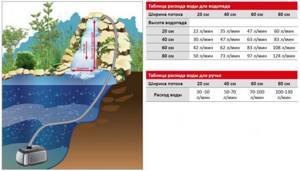
The design of any option is simple. The source of water is actually an artificial or natural reservoir in the garden. The water supply pump is placed at the bottom of the reservoir. The water supply pipe is laid at a low height. The water taken from the pool is returned to the reservoir.
This system is not closed. Some of the water evaporates as the jets reach the pool. If for a natural reservoir such a loss is little noticeable, since it is fed by groundwater, then in an artificial structure this deficiency must be covered.
1 stream of water requires 150–250 liters per hour. For a cascade with a shroud you need 400–600 liters. A solid wall of water will require up to 1200 liters. A waterfall that imitates a natural one, with rolling streams and foaming, will need at least 3500 liters per hour.
The 1-cascade option will spend from 2 to 5% of water per day on evaporation, that is, from 30 to 200 liters. The 3-jet option will lose from 90 to 600 liters per day. You need to make up for the loss by supplying water to an artificial pool. The capabilities of the local water supply are a decisive factor when choosing a model.
Creating a Water Tank
You can use old dishes as a container for water. Both plastic, ceramic and metal containers are suitable. If the waterfall is large enough, then the reservoir must be built specially. With this option, you need to take care of waterproofing the floor. For medium waterfalls, it is enough to find a container that will hold water. A glass aquarium installed on a hill can be used as a container. The only condition is that there are no leaks.
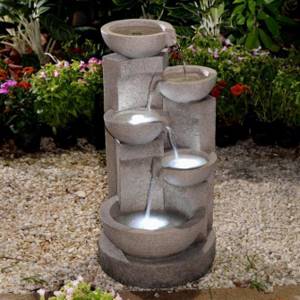
DIY installation
Making a waterfall with your own hands is not so difficult, but its maintenance will require a lot of expenses. Before starting construction, you need to assess your capabilities and weigh all the factors.
Necessary materials

To arrange an indoor or garden waterfall you will need:
- shovel, hammer, compaction device;
- tape measure, plumb line, level;
- since the basis for the artificial waterfall is a kind of concrete frame, the main construction material is concrete;
- if you make the concrete mixture yourself, you will also need a concrete mixer;
- boards or plywood for formwork;
- pipes - preferably plastic water pipes;
- pump - device is selected according to power.
A variety of materials are used to decorate the cascade: artificial and natural stones, brick and tuff, glass and green plants.
Pump selection
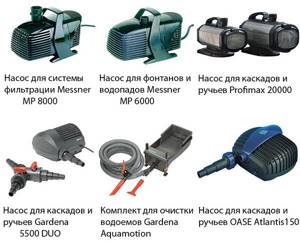
The second most important point when building a waterfall with your own hands at the dacha is the choice of pump. Its power is calculated based on the following considerations.
On average, the height of the cascade is 1 m, even if the stream falls into several bowls. Approximately the hourly flow rate here is 1 cubic meter, that is, the flow is from 0.27 to 0.3 liters per second. To raise 1 liter of water to a height of 1 m, it is necessary to do 1 kgf or 9.8 J of work. The power in 1 s in this case is 0.28 * 9.8 = 2.75 W.
The efficiency of a submersible pump is about 70%, less in cheap models. This means that to raise the specified volume of water, 2.75/0.7*3=11.8 W will be required. The value is multiplied by 5 to take into account the loss of power when the filters become clogged. The indicator is increased by another 20%, since voltage drops must also be taken into account. As a result, the minimum pump power for a 1-cascade waterfall 1 m high will be 75 W.
In the example given, it was assumed that the length of the supply pipe does not exceed 10 m. If the value is larger, the loss coefficient becomes higher: for a length of 15 m - 4, for 20 m - 6.5, for 30 - 7.2.
Construction stages
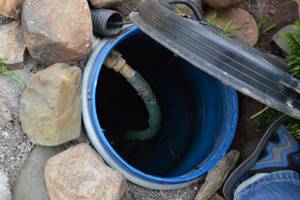
If there is a natural pond on the site, it is better to use it for the construction of cascades and waterfalls. If an artificial pool is being built, it will be done in parallel with the construction of a waterfall. The step-by-step instructions are complex, but the general construction guidelines are similar for both the construction of a cascade wall and a homemade pond from a bathroom.
- They dig a trench under the pond. Its dimensions also need to be calculated taking into account the capabilities of the water supply. The bottom is strengthened, usually concreted.
- Steps are built on one side of the pond. If there is no natural elevation near the reservoir, a slide is built from the removed soil and steps are formed in it.
- Formwork is installed on them and concrete is poured.
- After the material has completely dried, water pipes are laid: to supply water to the cascade, to supply water to the pool and for drainage.
- Decorate the bottom and steps in the chosen way.
- Pour water into the pool, install and connect the pump. Water should not be supplied under high pressure; a balance must be maintained between the volume of liquid supplied and received.
Then the plants are planted on the banks of the pond. Decorate the waterfall on the site with moss and lichen.
Advantages of using a waterfall in an apartment
Air humidity is an indicator not only of the physical comfort of the room, but also the state of the human immune system, since the well-being of the people living in it directly depends on the humidity of the air in the apartment. The optimal humidity level in winter is 60%, and in summer - about 80%.

If the air in the apartment is too dry, microbacteria develop in it, which leads to colds, especially in young children. Therefore, controlling air humidity is a mandatory rule for a healthy family.
If the apartment has a waterfall, a constantly falling stream of water refreshes and humidifies the air. The use of a waterfall also decorates the interior of the room. There are many options for finishing it: installing all kinds of lighting or combinations of lamps that create an amazing holiday atmosphere.
Water is a great way to calm down. It relieves overwork, stress and nervous tension. After looking at the waterfall for a few minutes, a person becomes calmer and more peaceful. The slight noise from the murmur of water allows you to avoid other unpleasant sounds that come from the street or from neighboring apartments.
The presence of a waterfall in the house increases comfortable conditions, protects against diseases, decorates the room and improves well-being. Therefore, building a waterfall with your own hands will bring only positive emotions. The advantage of a homemade waterfall over a purchased one is the ability to choose the size of the structure, the method of finishing it, decoration, and a variety of options for water fall.
Making a decorative waterfall eliminates problems such as splashing water and loud pump noise. In addition, they are very easy to care for.

Arrangement and decoration

How to make and decorate a waterfall depends on the chosen landscape. The decor is very varied:
- Natural - for example, in an English or Japanese garden, a cascade and a pond should look as natural as possible. For decoration, they take cobblestones covered with moss, pebbles and crushed stone, and plant shrubs and herbs on the shore. The pond with water lilies is very romantic.
- Rustic - the design includes a fence made of thin vines, clay figurines of birds, and jugs. The stones are more uniform and more flowering plants are planted.
- Modern design is strict. The steps here have distinctly geometric regular shapes, and the outlines of the pool are far from natural. Usually flowers are planted around the waterfall, and lighting is installed at the bottom of the pond;
- The French version prefers a waterfall in the form of streams flowing from bowl to bowl. This cascade and pond have beautiful marble sides, and neatly trimmed bushes grow around the pond. The best decor is marble and clay figurines of nymphs and fauns.
A do-it-yourself waterfall made of stones and concrete is an extremely effective and beautiful solution. This addition to the landscape gives the garden sophistication and harmony.
